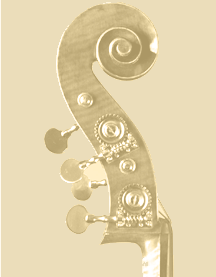Classical or Jazz upright bass?
An editorial on how versatility can make for
a more interesting and successful career in playing the upright
bass.
When I was 18 years old, I new that I wanted to play the bass (somehow)
for a living. It evolved from starting on the electric bass when
I was 15 all the way to playing Strauss' Also Spake Zarathustra
on the upright bass when I was in school at Indiana University,
just 3 short years later! To make a very long story short, playing
both Jazz and Classical upright bass made me an even better musician
than I if I had chosen just one genre or style.
For one, by playing both Jazz and Classical, I had my upright bass
in my hands that much more and therefore learned the instrument
quicker and more in depth. I think that really successful
upright players, love the instrument itself equally as much as any
other genre of playing. In other words, I was happy if I had my
bass in my hands!
Not only did I end up practicing more, whichever genre I was studying
more of at the time, would always carry over and reinforce what
I needed to know and learn on the other. Let's give a basic example:
No Jazz player will ever succeed unless he has a groove and pulse.
Jazz players call it "keeping time". It's the concept
of maintaining a good steady pulse throughout and supporting the
group of people you're playing with. What I found is that all the
Jazz playing that I did established this pulse feeling to my core
to the extent that I keep it with me now whenever I play, whether
it be classical or jazz.
It works the other way 'round as well. Studying classical will surely
help your jazz playing. I think music is certainly universal: The
simple truths in music hold true no matter what it is you're doing.
Music is music!
Why upright jazz-classical bass players
work more than anyone else:
This leads us into another great issue: Why just narrow your scope
of playing to just one or two genres? For high school upright bass
players, all the way up to professional upright bass players, being
versatile can make the difference of whether or not you can make
a true living at playing the upright bass at a professional level
or not. There are lots of smaller, regional orchestras that pay
a small, but consistent pay. With their 8-15 week seasons, and with
enough jazz gigs, many bass players can find their "niche'" this
very way.
What kinds of upright bass setups are available
for the Jazz-classical players?
This has to be where the biggest change and advancements have
been in the past 5-10 years. For one, there has been such a mass
improvement in the way the upright bass is set up: Including new
technical improvements with upright bass strings, upright bass pickups,
and the general way basses are set up to play. With the newer, high
quality steel strings, have enabled upright players a luxury of
much lower string action and height. Nowadays there are strings
that can actually "work" in a classical setting AND a
jazz setting. With the advent of the metal wound synthetic strings,
like Pirastro's Evah Prazzi or Obligatos. Some players prefer a
mix: The Pirastros on the top G and D, with a more "growling"
Thomastik Spirocore E. (We hope to have a page just dedicated to
specific set ups at a later date).
Upright bass is an extremely versatile instrument. Every symphony
needs at least 6-9 bass players and every acoustic jazz or bluegrass
group uses an upright bass. There is no other such instrument that
holds such an integral importance in such a wide spectrum. Learn
it all, then play it all! You then will have a musically rich life
as well as a successful profession.
- Steve Koscica
| |
 |
 |
|


